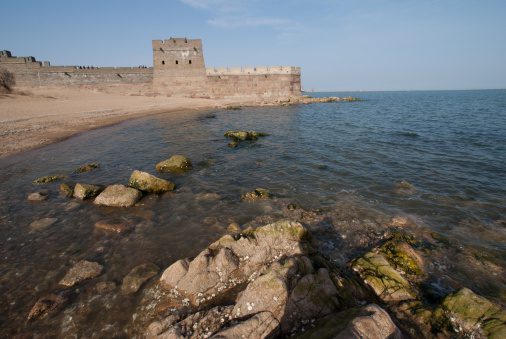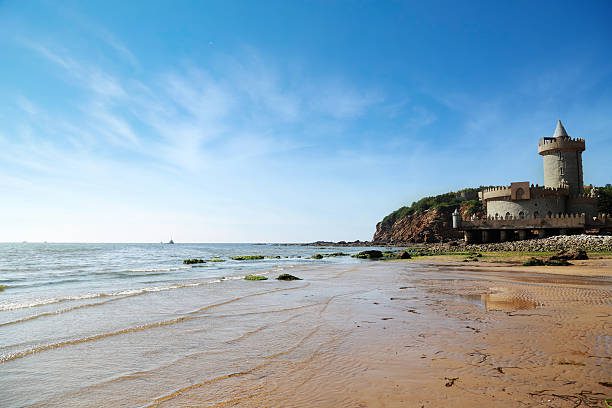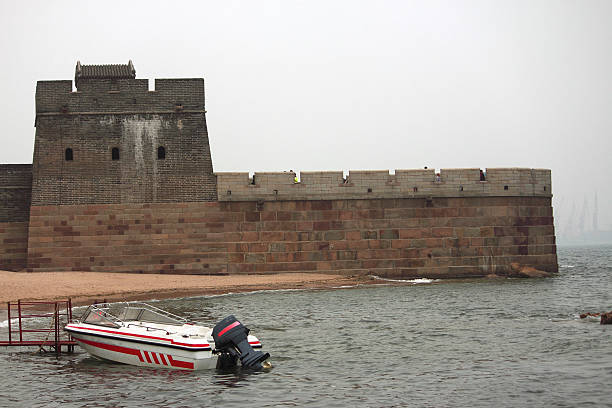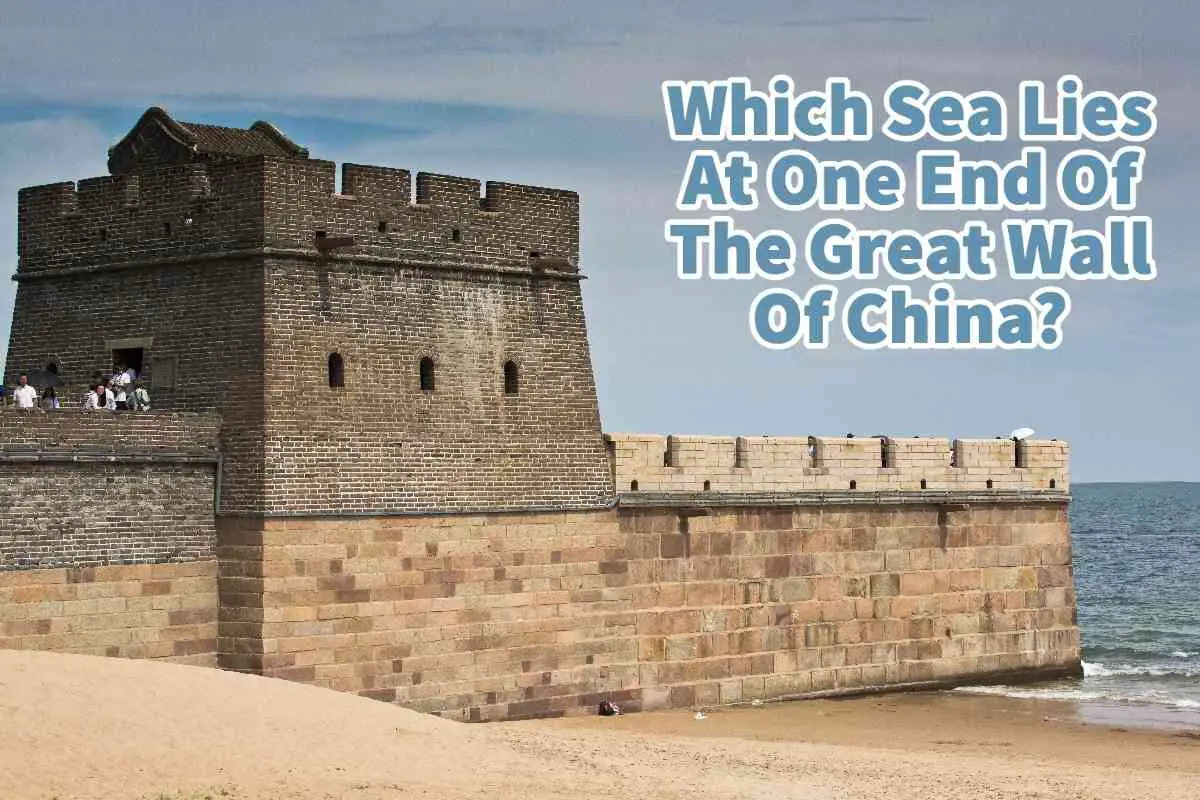The Great Wall of China is the world’s foremost construction project ever to take place. The Great Wall stretches throughout Northern China.
The Laolongtou, or the Old Dragonhead, is part of the Shanhai Pass of the Great Wall of China that goes right into the Bohai Sea. Most people consider this to be the start of the Great Wall of China. The Shanghai pass has always been of crucial military significance for China as it helps to protect China’s important capitals, including Beijing.
Table of Contents
- Identifying the Sea Bordering the Great Wall of China’s Start
- About the Shanhai Pass And The Great Wall
- 10 Fascinating Facts About the Great Wall of China
- Frequently Asked Questions
- Related Questions
Identifying the Sea Bordering the Great Wall of China’s Start
The Great Wall of China, an architectural marvel, winds through Northern China as the most significant construction project in history. At its eastern extremity lies the Laolongtou or Old Dragon’s Head, a segment of the Great Wall that extends into the Bohai Sea.
This point, part of the Shanhai Pass, is widely recognized as the beginning of the Great Wall. The strategic importance of the Shanhai Pass, especially in safeguarding key cities like Beijing, has been paramount throughout China’s history.
This juncture where the Great Wall meets the sea marks a significant geographical and historical confluence.
Shanhai Pass “The Old Dragon Head” – At The Bohai Sea

The Shanhai Pass of the Great Wall has a part called Laolongtou or “The Old Dragon Head,” which is part of the Great Wall of China at the Bohai Sea. The Bohai Sea is a small sea attached to the Yellow Sea; the Bohai Sea is in the northwestern and innermost extension of the Yellow Sea and connects to the east via the Bohai Strait.
The Old Dragon Head and the Jiaoshan Great Wall face each other from a distance; they proudly look between the mountain and sea passes. The Shanhai Pass is a crucial part and section of the Great Wall of China as it leads it from the Sea of Bohai to other cities of strategic importance, such as Beijing.
In Chinese, the word Shan means mountain, and hai means sea. Shanhai Pass gets its name because of its position between the mountain and the sea, particularly the Bohai Sea.
About The Bohai Sea And China

Until the early 20th Century, the Bohai Sea was called the Gulf of Jili or the Gulf of Pechihill or Pechili.
Today, the Bohai Sea is considered to be part of the territorial waters of the People’s Republic of China. Three parts of China’s provinces enclose the Bohai Sea: Liaoning Province of Northeast China, Hebei Province, Tianjin Municipality, and Shandong Province. Today the Bohai Sea is a very busy waterway.
The Bohai Sea is a semi-enclosed continental shelf sea in Northern China. It is considered off the Yellow Sea or the Northwest Pacific Ocean.
The sea comprises many bays, including Liaodong Bay, Bohai Bay, Laizhou Bay, Central Bohai Sea, and Bohai Straits. The Liaohe River, Haihe River, and Huanghe River basins flow into the Bohai Sea. The Bohai Sea is strategically important as it connects to the Yellow Sea.
About the Shanhai Pass And The Great Wall
The original Shanhai Pass was built during the Ming Dynasty, which ruled China from 1368 to 1644. The Old Dragon Head of the Shanhai Pass extends about 20 meters or 66 feet Into the Bohai Sea. The Old Dragon Head is constructed to symbolize a dragon drinking water from the Bohai sea.
When you think about when the Old Dragon Head of the Shanhai Pass was built, it is incredible that the ancient contractors built part of it right out into the Bohai Sea.
The Old Dragon Head of the Shanhai Pass guards the narrow passage between Northeastern and Central East China.
Further down from the Old Dragon Head is the Shanhai pass. The Shanhai Pass is built as a square with a perimeter of around four kilometers or 2.5 miles. The wall reaches a height of 14 meters or 48 feet. The walls are 7 meters or 23 feet thick.
A deep, wide moat and drawbridges over it surround the east, south, and north sides. In the middle of the pass stands a tall bell tower.
History Of The Shanhai Pass And The Great Wall

The Shanhai Pass of the Great Wall of China has a long history of more than 600 years. The past has been considered very important to the military since ancient times.
Most of the Shanhai pass walls are well preserved and have their original look and structure. This makes it an essential part of the Great Wall as it retains its historical importance.
Here is the historical importance of the Shanhai pass:
- Built in 583 – The Shanghai Pass was built in 583.
- Renovated Throughout History – The pass was then renovated several times throughout history.
- Ming Transformed The Pass – the Ming Dynasty transformed the Pass into a formidable military stronghold or the Pass as we know it today. In 1381, General Xu Da of the Ming Dynasty led the construction of the Shanhaiguan or the Shanhai Great Wall, including the Shanhai Pass.
The Shanhai Pass has been a crucial military construction in China for hundreds of years and has also been an essential part of the military strategy to protect China. The Shanhai Pass helps to protect the two ancient capitals of both Beijing and Chang’an or present-day Xian.
Shanhai Pass Fortress Tower
The tower at the east gate of the Shanhai Pass fortress is a historical building; the tower was built on top of the wall to overlook the plains.
Hanging above the tower’s gate hangs a plaque that reads “First Pass Under Heaven.” Xiao Xian, a famous calligrapher during the Ming Dynasty, wrote the plaque.
The Shanhai Fortress is not on the sea as the Dragon’s Gate; it is located on the Bohai Sea and stretches out to the sea. Standing on the ancient wall of the Shanhai Pass, you can look north and see the majestic shape of the Jiaoshan Great Walla, and to the south, you can look towards the Old Dragon’s head or the Bohai Sea.
Shanhai Pass Gates And Towers
The Shanhai Pass of the Great Wall has gates and towers. Some other towers stand on the north and south sides of the fortress tower.
The area includes other buildings, including the north, south, east, and west gates. The north, south, east, and west gates remain intact.
10 Fascinating Facts About the Great Wall of China
The Great Wall of China, a marvel of engineering and a testament to human perseverance, remains one of the most iconic structures in the world.
Here are ten intriguing facts to enhance your understanding of this monumental creation:
- Not a Continuous Wall: Contrary to popular belief, the Great Wall isn’t one continuous structure. It’s a collection of walls and fortifications built by various dynasties over centuries, primarily to fend off invasions.
- Staggering Length: The total length of the Great Wall and its branches is around 21,196 km (13,171 miles). That’s more than half the circumference of Earth!
- Ancient Foundations: The earliest walls date back to the 7th century BC during the Warring States period. However, most of the existing wall is from the Ming dynasty (1368–1644).
- Diverse Materials: Depending on the terrain and availability of resources, different sections were constructed using materials ranging from earth and wood to bricks, tamped earth, and stone.
- Manned by Massive Forces: At the height of its use, the Wall was guarded by over a million soldiers. These included regular armies, border troops, and even forcibly conscripted peasants.
- Signal Towers: The Wall also functioned as a high-speed communication system. Signal towers or beacon towers were used to relay messages, with smoke signals during the day and fires at night.
- Cultural Significance: The Wall is often seen as a symbol of the Chinese people’s strength, tenacity, and unity. It’s frequently mentioned in Chinese literature, poetry, and songs.
- Tourist Magnet: Badaling, near Beijing, is the most visited section of the Wall. It was the first to open to tourists in 1957 and has since seen hundreds of millions of visitors, including numerous world leaders.
- Endangered Marvel: Large sections of the Wall are in ruins, having been eroded by natural elements and human activities. Efforts are ongoing to preserve and restore this UNESCO World Heritage site.
- Space View Myth: A common myth is that the Great Wall is visible from the Moon with the naked eye. In reality, it’s very challenging to see the Wall from low Earth orbit without aid, let alone from the Moon!
With its vast expanse and rich history, the Great Wall of China continues to be a source of awe and inspiration. Delving deeper into its intricacies and tales only adds to the fascination surrounding this monumental achievement of human civilization.
At A Bus On A Dusty Road, we talk about everything about travel, life, sailing, and ex-pat living. We are all about “Living Life As A Global Citizen.” We explore social, cultural, and economic issues and travel.
We would love to have you be part of our community. Sign up for our newsletter to keep up-to-date by clicking here. If you have any questions, you can contact me, Anita, by clicking here.
Listen to our Podcast called Dusty Roads. You can find it on all major podcast platforms. Try out listening to one of our podcasts by clicking here.
Subscribe to our A Bus On A Dusty Road YouTube Channel filled with great videos and information by clicking here.
Frequently Asked Questions
Which sea lies at one end of the Great Wall of China?
The Bohai Sea lies at one end of the Great Wall of China, specifically at the Laolongtou or Old Dragonhead, part of the Shanhai Pass.
Why is the Bohai Sea significant in relation to the Great Wall?
The Bohai Sea is significant because it marks the endpoint of the Great Wall at Laolongtou, a crucial defensive structure designed to protect China’s important capitals, including Beijing.
Is the Bohai Sea the only body of water associated with the Great Wall’s endpoint?
Yes, the Bohai Sea is the primary body of water associated with the endpoint of the Great Wall at Laolongtou. It holds historical and strategic importance for China.
What is Laolongtou, and how does it relate to the Great Wall?
Laolongtou, or the Old Dragonhead, is a section of the Great Wall located at the Shanhai Pass. It is considered the starting point of the Great Wall and extends into the Bohai Sea.
Why is Shanhai Pass strategically important for China’s defense?
Shanhai Pass is strategically important because it serves as a key defensive point, protecting important capitals like Beijing. Its location allowed for control over access to northern China.
How long is the Great Wall of China, and does it run continuously to the Bohai Sea?
The Great Wall of China is approximately 13,170 miles (21,196 kilometers) long. While it doesn’t run continuously to the Bohai Sea, the endpoint at Laolongtou reaches into the sea.
What historical significance does the Bohai Sea have in relation to the Great Wall’s construction?
The Bohai Sea’s proximity to the Great Wall signifies the strategic planning involved in its construction, emphasizing the importance of maritime defense in addition to land defense.
Were there specific reasons for choosing the Bohai Sea as the endpoint of the Great Wall?
Yes, the choice of the Bohai Sea was strategic, providing both a physical barrier and a naval defense point, adding an extra layer of protection to China’s northern borders.
Can visitors access the endpoint of the Great Wall at Laolongtou and witness its connection to the Bohai Sea?
Yes, visitors can access the endpoint of the Great Wall at Laolongtou and observe its connection to the Bohai Sea, experiencing firsthand the historical and geographical significance of this location.
Are there other notable landmarks or features near the Bohai Sea endpoint of the Great Wall?
Yes, in addition to Laolongtou, visitors can explore the Shanhai Pass area, which includes historical landmarks and structures that played a role in the defense and history of northern China.
Related Questions
How Much Does The Great Wall Of China Weigh?
If you calculate the approximate number of bricks and the weight of each of those, the Great Wall of China would weigh over 50,000,000 tons. The Great Wall is considered the heaviest continuous structure on the face of the earth. As so many bricks were used to build the wall, if you put all the bricks side by side, it would go around the equator about 36 times.
By clicking here, you can discover How Much Does The Great Wall Of China Weigh?.
Are There Dead Bodies Inside The Great Wall Of China?
Bodies would not have been buried right into the wall, but they could have been buried in the earth near and even under the wall. They would not have put them right into the wall, as it would have caused structural damage when the bodies decomposed. The bodies are probably buried right by the wall, under some stone, and other slabs.
You can learn more by reading Are There Dead Bodies Inside The Great Wall Of China? by clicking here.
How Long Did It Take to Build the Whole Great Wall of China?
The Great Wall of China took over 2,000 years to build. The building span many Chinese Dynasties or for about 22 centuries. The construction of the wall ended in the Ming Dynasty in 1644. The Great Wall is one of the most significant human-made construction projects globally; the Great Wall is over 21,196 kilometers or 13,171 miles. There are over 25,000 watchtowers scattered throughout the Great Wall structure.
To know more about How Long Did It Take to Build the Whole Great Wall of China? by clicking here.


